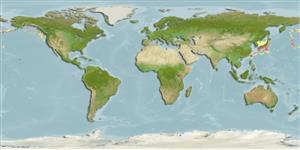Heteronymphon horikoshii Nakamura, 1985
| Native range | All suitable habitat | Point map | Year 2050 |

|
| This map was computer-generated and has not yet been reviewed. |
| Heteronymphon horikoshii AquaMaps Data sources: GBIF OBIS |
Upload your photos
Google image |
No photo available for this species.No drawings available for Nymphonidae.
Google image |
No photo available for this species.
Classification / Names Common names | Synonyms | CoL | ITIS | WoRMS
Pycnogonida | Pantopoda | Nymphonidae
Environment: milieu / climate zone / depth range / distribution range Ecology
Benthic; depth range 700 - 2000 m (Ref. 2153). Temperate
Distribution Countries | FAO areas | Ecosystems | Occurrences | Introductions
North Pacific: Alaska and Japan.
Length at first maturity / Size / Weight / Age
Maturity: Lm ? range ? - ? cm
Short description Morphology
A slender, attenuated species. Lateral processes separated proximally by less than twice their diameters. Ocular tubercle a broad cone as tall as wide, situated at anterior of cephalic segment. Anterior eye pair much larger than posterior pair. Proboscis slender, only about as long as cephalic segment. Abdomen slender, not longer than posterior lateral process pair.
Chelifore scapes equal in length to proboscis, chelae slender, fingers almost equal in length to palm, armed with 18 to 23 small teeth. Palp third segment longest, fourth longer than fifth. Legs very slender, second tibiae very long, first tibiae longer than femora. Propodus only slightly longer than tarsus (Ref. 2153, p. 19).
Deep slope (Ref. 19).
Life cycle and mating behavior Maturity | Reproduction | Spawning | Eggs | Fecundity | Larvae
Members of the class Pycnogonida are gonochoric and sexually dimorphic. During copulation, male usually suspends itself beneath the female. Fertilization occurs as the eggs leave the female's ovigers. Males brood the egg masses until they hatch. Life cycle: Eggs hatch into protonymphon larva then to adults.
Main reference
References | Coordinator | Collaborators
Child, C.A. 1995. (Ref. 2153)
IUCN Red List Status (Ref. 130435)
CITES status (Ref. 108899)
Not Evaluated
CMS (Ref. 116361)
Not Evaluated
Threat to humans
Human uses
| FishSource |
Tools
More information
Internet sources
BHL | BOLD Systems | CISTI | DiscoverLife | FAO(Publication : search) | Fishipedia | GenBank (genome, nucleotide) | GloBI | Gomexsi | Google Books | Google Scholar | Google | PubMed | Tree of Life | Wikipedia (Go, Search) | Zoological Record
Estimates based on models
Price category
(Ref. 80766):
Unknown.


